
👉ITA Version👈 (ENG Ver below)
Per chi ha avuto il piacere di leggere le puntate precedenti, chi non lo ha fatto le trova ai link sotto, voglio continuare a raccontarvi della mia gita per Roma da turista autoctona.
Piazza di Spagna: https://ecency.com/hive-146620/@sissim72/ita-eng-my-city-my
Fontana di Trevi: https://ecency.com/hive-146620/@sissim72/ita-eng-my-city-my-ca272aabfcc57
Dopo Piazza di Spagna, una lunga camminata per arrivare a Fontana di Trevi, mi sono incamminata di nuovo per la parte opposta del Centro di Roma.
Il mio obiettivo finale era il Colosseo, ma perdendomi nelle viuzze, ho raggiunto il Pantheon.
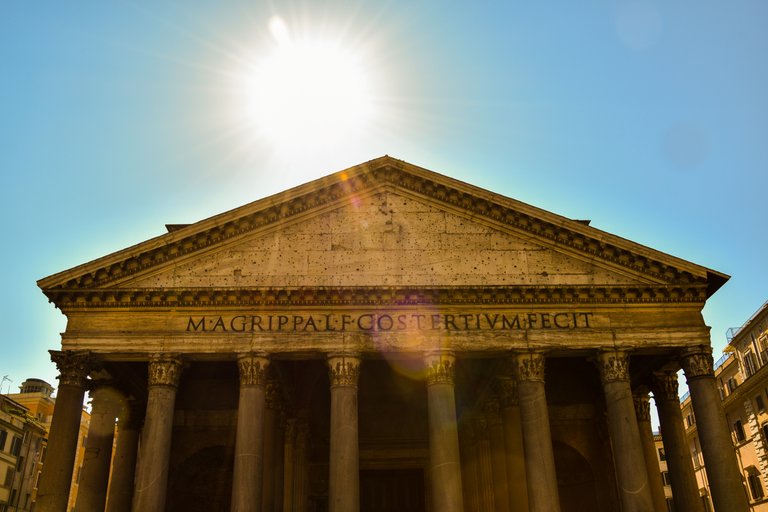
Il Pantheon è forse uno dei monumenti che a me personalmente affascinano di più.
Fu costruito da Marco Vipsiano Agrippa, della Gente Giulia, quindi della famiglia di Giulio Cesare e il primo Imperatore Ottaviano Augusto (insomma un piccolo Pedigree) come dimostra anche la modesta scritta sul frontale e come dice il suo nome che deriva dal Greco Pan (tutti) Theon (gli dei) è un tempio dedicato a tutte le divinità.
Ora che i Romani dedicassero un Tempio nella città capitale dell’impero a tutte le divinità visto che perseguivano chi non adorasse gli dei patrii è un pochino improbabile.
E’ quindi molto più plausibile che Pantheon (o Panteum in latino) fosse un soprannome dovuto al fatto che all’interno si trovassero 12 statue delle più importanti divinità dell’epoca.
A parte questa digressione storico artistica, la cosa più affascinante del panteon è la sua struttura architettonica, che è una struttura circolare unita ad un portico con colonne sormontata da una cupola in calcestruzzo con un occhio centrale che dona luce all’interno.
La cupola del Pantheon è stata costruita con un unica gittata di calcestruzzo, ebbene sì, hanno colato 5000 tonnellate di cemento, su uno stampo di legno, è a tutt’oggi la cupola più grande del mondo in diametro, all’interno forata con cassettoni per alleggerirne il peso.
Ancora oggi una meraviglia architettonica sulla quale gli studiosi si interrogano come abbiano fatto con gli strumenti dell’epoca.
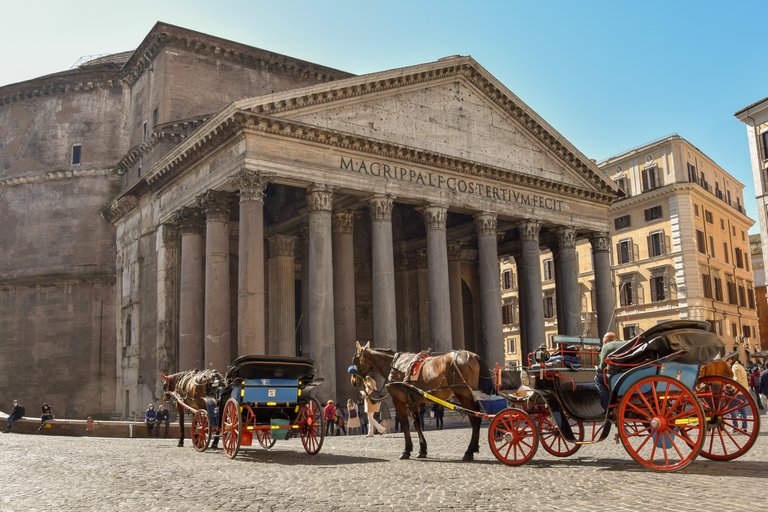
Ed eccola qui, Sua Maestà, con annesse carrozzelle per giro turistico e romantico per il centro storico. Io non l'ho mai fatto, troppo caro.
Inoltre devo dire che non mi piace molto vedere questi cavalli costretti a trottare sull'asfalto, che a Roma, in Estate, raggiunge temperature elevatissime.
Capisco però che sia molto caratteristico ed affascinante per i turisti, ma lo trovo alquanto anacronistico.
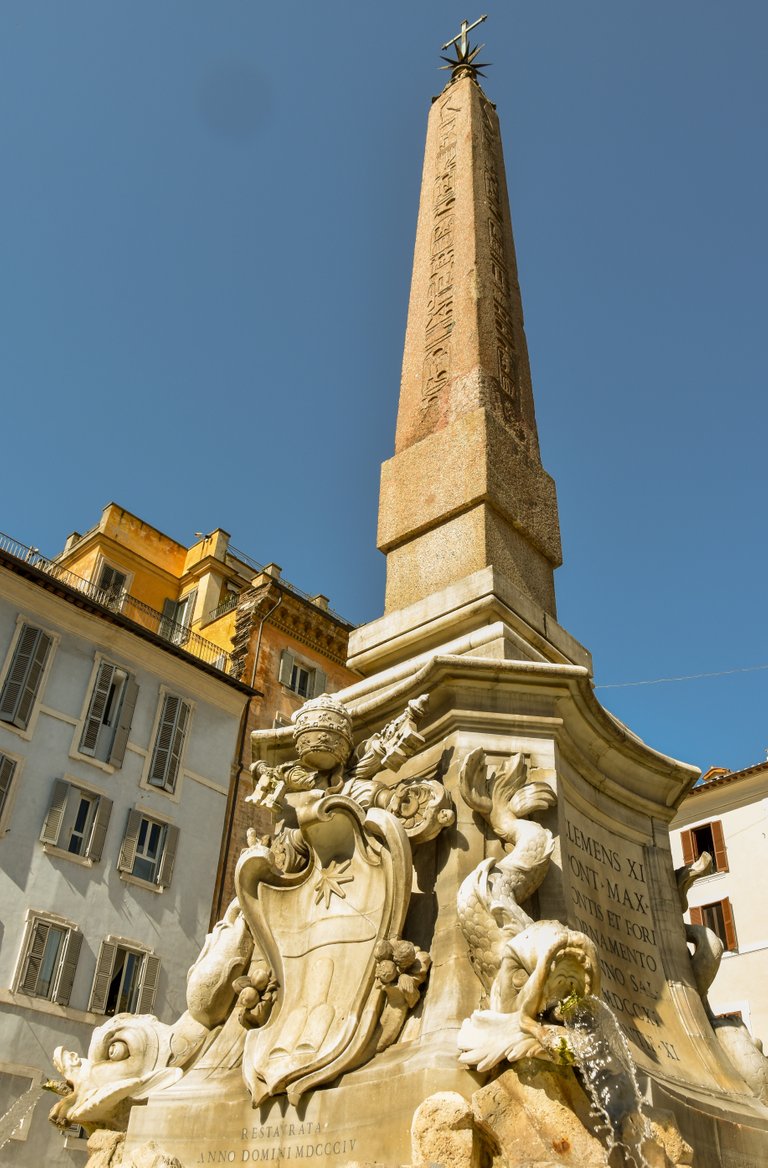
La piazza antistante il Pantheon si chiama Piazza della rotonda ed ospita una bellissima fontana risalente al XVI secolo dove l’acqua sgorga da quattro mascheroni su disegno di Michelangelo.
Nel 1700 la fontana, che era un catino, venne restaurata e venne posto un obelisco Egizio su un gruppo di rocce con delfini, quindi completamente stravolta e molto più barocca.
Ma di certo di grande impatto scenografico nella centralità della piazza e un’ottima cornice per il maestoso Tempio Romano.
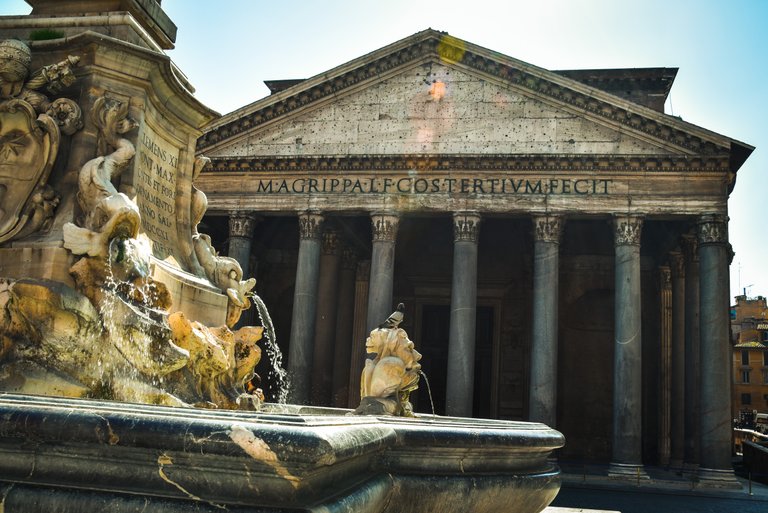
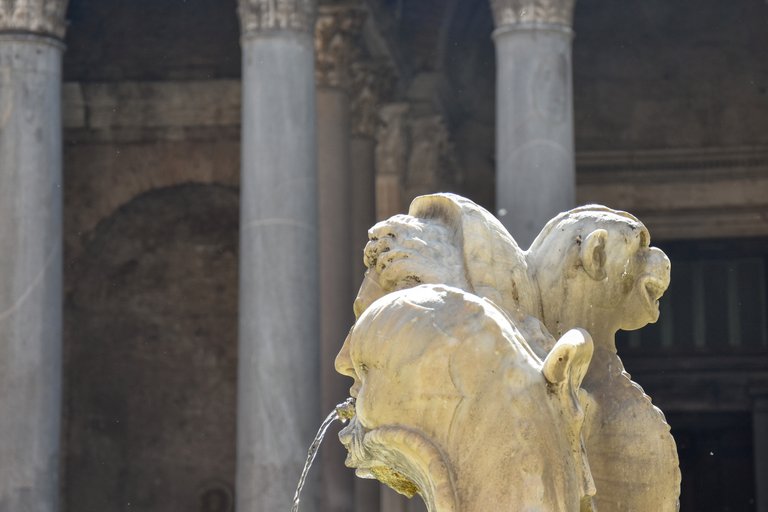
La giornata era tiepida, il cielo era terso, sono arrivata sulla piazza controsole per le foto ma devo dire che i giochi di luce che si sono creati mi piacciono molto.
Sono rimasta seduta sui gradini della piazza, avrei voluto prendere un caffè ma non mi sono fidata per il Covid.
Le persone non erano moltissime, ma sicuramente non ero più totalmente sola, poi si stava facendo mezzogiorno e mi stava venendo un certo appetito.
A farmi compagnia c'erano i piccioni che facevano amabilmente il bagno nella fontana e si asciugavano al Sole, per nulla infastiditi dalla mia presenza.
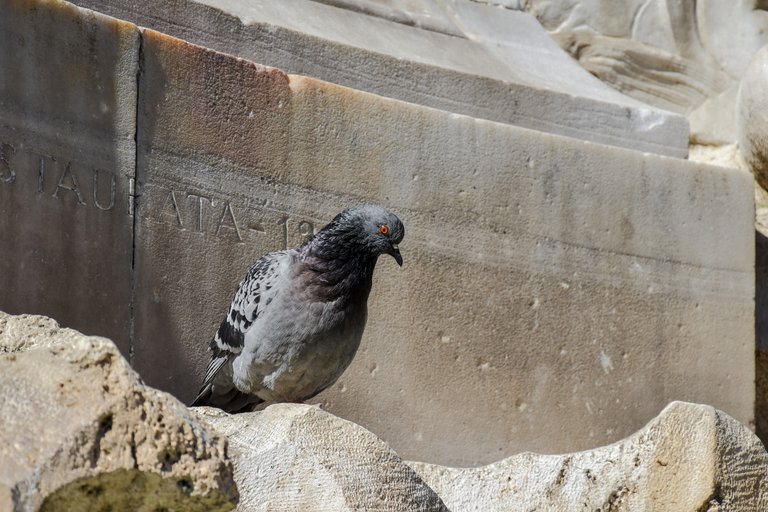
Il tempio era chiuso, quindi non ho potuto visitare l'interno.
Il tempio, prima pagano e poi trasformato in una chiesa Cristiana, accoglie le spoglie dei reali d’Italia, in particolare Umberto I e Margherita di Savoia e un pavimento di marmi policromi resi ancor più belli dai giochi di luce che entrano attraverso l’occhio della cupola.
La decorazione del soffitto, come una volta celeste, è andata irrimediabilmente perduta.
Gli scatti sono stati realizzati con una Nikon D5500 obiettivo 18-105.
Vi auguro una piacevole serata e grazie per la lettura.
A presto 😊

👉ENG Version👈

For those who have had the pleasure or the courage to read the previous episodes, those who have not done so can find them at the links below, I want to continue telling you about my trip to Rome as an indigenous tourist.
Spanish Steps: https://ecency.com/hive-146620/@sissim72/ita-eng-my-city-my
Trevi Fountain: https://ecency.com/hive-146620/@sissim72/ita-eng-my-city-my-ca272aabfcc57
After the Spanish Steps, a long walk to get to the Trevi Fountain, I walked back to the opposite side of the center of Rome.
My final goal was the Colosseum, but getting lost in the alleys, I reached the Pantheon.

The Pantheon is perhaps one of the monuments that fascinate me the most personally.
It was built by Marco Vipsiano Agrippa, of the Gens Giulia, therefore of the family of Julius Caesar and the first Emperor Octavian Augustus (in short, a very good pedigree) as evidenced by the modest writing on the front and, as its name which derives from the Greek Pan (all ) Theon (the gods), it is a temple dedicated to all deities.
Now, having the Romans dedicated a temple in the capital city of the empire to all the divinities as they persecuted those who did not worship the patrii gods, it is a little unlikely.
It is therefore much more plausible that Pantheon (or Panteum in Latin) was a nickname due to the fact that inside there were 12 statues of the most important divinities of the time.
Apart from this historical and artistic digression, the most fascinating thing about the pantheon is its architectural structure, which is a circular structure combined with a portico with columns topped by a concrete dome with a central eye that gives light inside.
The dome of the Pantheon was built with a single throw of concrete, yes, they poured 5000 tons of concrete, on a wooden mold, it is still the largest dome like this in the world in diameter, inside perforated with caissons to lighten its weight.
Still today an architectural marvel on which scholars wonder how they could do it with the tools of the time.

And here it is, His Majesty, with attached wheelchairs for a touristic and romantic tour of the historic center. I've never done it, too expensive.
Furthermore, I must say that I don't really like seeing these horses forced to trot on the asphalt, which in Rome, in the summer, reaches very high temperatures.
However, I understand that it is very characteristic and fascinating for tourists, but I find it somewhat anachronistic.

The square in front of the Pantheon is called Piazza della Rotonda and houses a beautiful fountain dating back to the sixteenth century where water flows from four masks designed by Michelangelo.
In 1700 the fountain, which was a basin, was restored and an Egyptian obelisk was placed on a group of rocks with dolphins, therefore completely distorted and much more Baroque.
But certainly of great visual impact in the centrality of the square and an excellent setting for the majestic Roman Temple.


The day was warm, the sky was clear, I arrived on the square against the sun for the photos but I must say that I really like the play of light that has been created.
I sat on the steps of the square, I wanted to have a coffee but I was scared of Covid.
There weren't very many people, but I was certainly no longer totally alone, then it was getting to midday and I was getting a certain appetite.
To keep me company there were the pigeons who bathed amiably in the fountain and dried themselves in the sun, not at all bothered by my presence.

The temple was closed, so I couldn't visit the inside.
The temple, first pagan and then transformed into a Christian church, houses the remains of the royals of Italy, in particular Umberto I and Margherita di Savoia and a floor of polychrome marble made even more beautiful by the play of light that enters through the eye of the dome.
The decoration of the ceiling, like a celestial vault, has been irretrievably lost.
The shots were taken with a Nikon D5500 18-105 lens.
Have a nice evening and thanks for reading.
See you soon 😊






